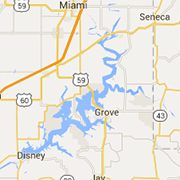Shoreline Cleanup Near Grove Completed

In spite of heavy fog, the shoreline cleanup program that was conducted last Thursday near Sailboat bridge in Grove was very successful. Thanks to the hard work of personnel from several lake area companies including Goldner Company, Shepherd’s Dock Construction, DD Welding and Fabrication, Premier Dock Construction LLC, The Dock Guys, Eagles Landing Resort and inmate work crews from the Oklahoma Department of Corrections, we were able to remove over four tons of debris, mostly styrofoam, from 15.5 miles of shoreline of Grand Lake in the areas of Wolf Creek, Hickory Creek and from the north and south shorelines from the Wolf Creek Recreational Park to the mouth of the Elk River. A similar project held in July resulted in the removal of over six tons of debris from the Duck Creek area. The group of nearly 30 people worked from the water using five boats and a barge. This is the second such project organized by Scott Horton of the GRDA Shoreline Management Team, assisted by GRDA Police. The location chosen for this project was based on aerial observation made during regular helicopter flights over the lakes area to determine the areas in most need of debris removal. Future projects for shoreline debris removal will be planned in coming months to focus attention on other areas of GRDA lakes.
As Temperatures Drop, be Cautious of Cold Water Shock
In spite of what the calendar may say, the unseasonably warm weather does not necessarily hold true with water temperatures. On a sweltering day, your first instinct might be to jump into the nearest body of cold water as fast as you can. That could be a dangerous mistake, especially as we see water temperatures begin to drop with the changing of the seasons. In the U.S., there's an average of more than 3,500 unintentional drowning deaths each year, according to the Centers for Disease Control and Prevention. While cold water shock deaths are relatively rare, recreational boating safety specialists for the U.S. Coast Guard believe a number of unexplained natural water drownings in the U.S. could be linked to the condition. Cold water shock can happen fast. It's most easily explained as that involuntary gasp you take when jumping into any body of water below 70 degrees. In comparison, the suggested water temperature for the average multi-purpose pool is 84 to 86 degrees. In reality, anything below the temperature of your own body can put you at risk. For many people, that range would be from 55 degrees to 70 degrees Fahrenheit. That may not seem cold, but the average body temperature is 98.6 degrees Fahrenheit — so it's an almost 30-degree difference that can literally take your breath away.
If you take that involuntary gasp for air when you're under water (after jumping in), you may aspirate, or swallow water, which can lead to panic and can start the drowning process. This type of shock can also create conditions for a heart attack. The body starts pumping adrenaline, which creates changes in the blood vessels in your heart — anyone at risk for heart disease can have a heart attack. It can also put people who experience arrhythmia of the heart at risk, and people may not know if they have that condition. If you're able to catch your breath — which is difficult enough to do — the second phase of cold water shock is cold incapacitation — which causes your muscles to eventually stop working. Experts say that in 50-degree water, you might have as little as ten to 15 minutes of manual dexterity, where you should try to get back on your boat or signal for help in some way. If the water is cold, it's only a matter of time before you can lose control of your arms and legs. Cold water shock or incapacitation is likely why so many boaters, fishermen, hunters and others drown so quickly, research has shown. People living in northern regions of the country or in areas with large, rapid flowing rivers can be more at risk. Most people think of hypothermia (drop in body temperature) when they think of cold water, but the reality is that if you don't have a life jacket, you will not live to experience hypothermia — you'll may drown or go unconscious first.
Tips for how to stay safe in cold water:
Dress for the temperature: For paddle boarding or surfing, wear a wet suit and always attach to your board.
Wear a life jacket: A life jacket buys you time to catch your breath, to rescue yourself and to wait for rescue.
Walk in slowly to better acclimate to cold water temperatures: Any temperature of water that your body is not accustomed to poses a threat. The surface of a body of water is usually warmer than the temperature of that water a few feet below. Even if you dip your toe in and it feels OK, don't risk quickly submerging your body.
If you start shivering or your limbs start to feel stiff, get out of the water immediately: Even if you're ordinarily a great swimmer, the cold water can immediately debilitate you.
GRDA Closes Access to Low Water Dam for Refurbishment
Beginning on October 30th, dependent upon GRDA ability to control river flow, GRDA Hydro Excavation staff will undertake activity for maintenance repairs of the Oklahoma Ordinance Works Authority Low Water Dam within the Ft. Gibson Reservoir. The project is located in Mayes County, southeast of Pryor, at the west end of County Road E0550, approximately 1.1 miles west of the intersection of E0550 with S4370. The Low Water Dam maintenance work is anticipated to take 5 to 6 days, assuming there are no weather or other delays that would slow or stop construction progress. While working in the river, river flow will be controlled at the GRDA Markham Ferry (Kerr) and Pensacola Dams. Flow will be ceased at these facilities to eliminate the flow over the Low Water Dam. During construction, temporary barriers will be placed around the construction area to restrict pedestrian and vehicular access to the work site around and near the low water dam. GRDA Police Department will be conducting regular patrols around the area to ensure the public does not enter the closed area during the time of this project. Work is expected to be completed by November 8th, if weather and water conditions cooperate.
Limited Time Remains for the Public to Participate in Online Illinois River User Survey
Time is running out for the public to provide their input on how GRDA manages the Illinois River in the future. The Grand River Dam Authority is asking for the public’s help on how to manage this jewel of recreation for the state. GRDA has contracted with Oklahoma State University to conduct a survey about the public’s experiences on the river and the value it places on this natural resource. This online survey – which can be found at https://goo.gl/uFG6xb – will be active only a short time and takes approximately 15 minutes to complete. Anyone who has experienced the river is invited to participate. We want the public’s input as we shape our management plan, so the more river users we can get involved in this survey, the better. We’re encouraging everyone who has experienced these waters to take part in the survey. Those experiences include floating, fishing, swimming, sight-seeing, camping or any other activity related to the water. The survey includes questions about the most recent experience on the river and also provides the opportunity for the public to evaluate floating experiences and to suggest improvements and enhancements to river management.






